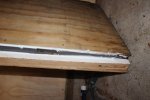Hi,
A quick question during a break from my garage to studio conversion. I have created a set of side hinging door that are well soundproofed and will be well sealed as well. They are wooden brace and ledge and framed doors with 21mm panels....recesses filled with Celotex 25mm. Boxed in, filled with 100m rockwool (RWA45) and sealed in with 12.5mm soundblock plasterboard.
Inside that I have a second 'door' barrier. It consists of a fake wall that hinges back (long story but for building regs I have to maintain the ability to drive a car into the garage even if I choose not to) and a standard interior house door that will be used to get through to the studio. The fake wall is a frame made of 3 x 2 wood, filled with same rockwool and sandwiched each side with the same sounblock plasterboard. All moving parts are an 'interference fit' and I will be using various different acoustic / draft proofing seals to make everything as airtight as possible.
At the moment the interior door is the weak point as it is a standard new build (cheap) door. Obviously I will make air tight seal all around....but the question is the best way to soundproof.
Do I:
1. Add 2 or 3 layers of 12.5mm soundblock plasterboard to the back of the door?
2. Box in the back of the door with the above plasterboard and fill with 100mm rockwool (which I have left over from other parts of the studio build).
3. Do something else?
Many thanks,
Andy
PS - just how soundproof do you think you can make the front of a garage (2.1 x 2.1 metre opening) with wood/plasterboard/rockwool doors? It's been suggested that the only way to do it is with uPVC doors but at that size I have been quoted in the region of £1000 to make and fit them.
A quick question during a break from my garage to studio conversion. I have created a set of side hinging door that are well soundproofed and will be well sealed as well. They are wooden brace and ledge and framed doors with 21mm panels....recesses filled with Celotex 25mm. Boxed in, filled with 100m rockwool (RWA45) and sealed in with 12.5mm soundblock plasterboard.
Inside that I have a second 'door' barrier. It consists of a fake wall that hinges back (long story but for building regs I have to maintain the ability to drive a car into the garage even if I choose not to) and a standard interior house door that will be used to get through to the studio. The fake wall is a frame made of 3 x 2 wood, filled with same rockwool and sandwiched each side with the same sounblock plasterboard. All moving parts are an 'interference fit' and I will be using various different acoustic / draft proofing seals to make everything as airtight as possible.
At the moment the interior door is the weak point as it is a standard new build (cheap) door. Obviously I will make air tight seal all around....but the question is the best way to soundproof.
Do I:
1. Add 2 or 3 layers of 12.5mm soundblock plasterboard to the back of the door?
2. Box in the back of the door with the above plasterboard and fill with 100mm rockwool (which I have left over from other parts of the studio build).
3. Do something else?
Many thanks,
Andy
PS - just how soundproof do you think you can make the front of a garage (2.1 x 2.1 metre opening) with wood/plasterboard/rockwool doors? It's been suggested that the only way to do it is with uPVC doors but at that size I have been quoted in the region of £1000 to make and fit them.


